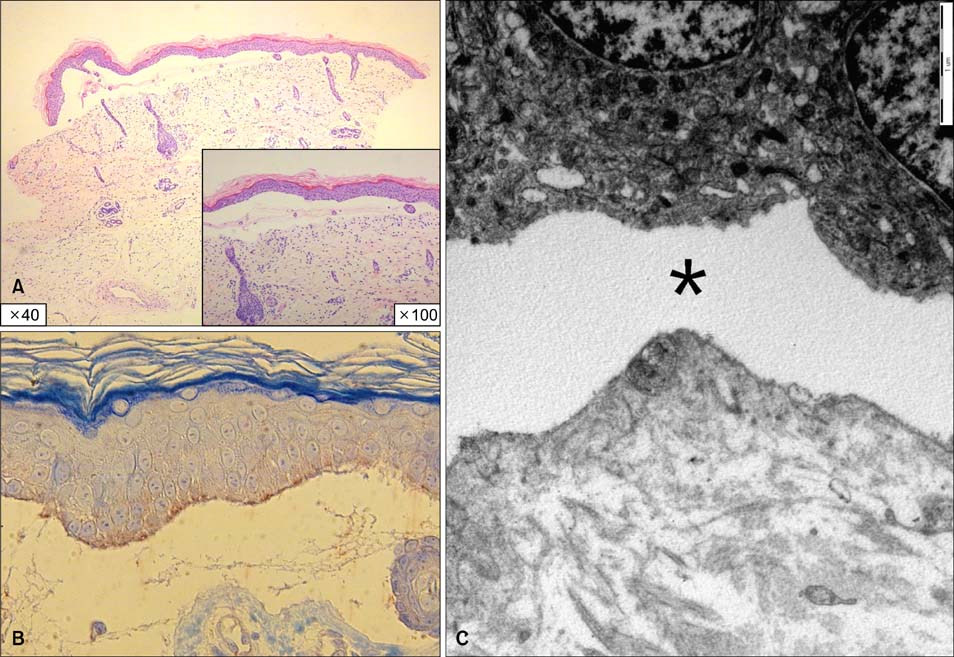Ann Dermatol.
2011 Sep;23(Suppl 1):S41-S44. 10.5021/ad.2011.23.S1.S41.
Case of Epidermolysis Bullosa with Pyloric Atresia
- Affiliations
-
- 1Department of Dermatology, Yonsei University Wonju College of Medicine, Wonju, Korea. choieh@yonsei.ac.kr
- 2Department of Pathology, Yonsei University Wonju College of Medicine, Wonju, Korea.
- KMID: 2156748
- DOI: http://doi.org/10.5021/ad.2011.23.S1.S41
Abstract
- Epidermolysis bullosa (EB) is a rare hereditary disorder characterized by formation of blisters following minor trauma. It has been traditionally categorized by the level of basement membrane zone separation into EB simplex (EBS), junctional EB (JEB), and dystrophic EB (DEB). Recently, hemidesmosomal EB has been proposed as a fourth category, which includes EB with muscular dystrophy and EB with pyloric atresia. We report here on a case of concomitant occurrence of EB and pyloric atresia, a rare form of EB.
MeSH Terms
Figure
Reference
-
1. Marinkovich MP, Bauer EA. Wolff K, Goldsmith LA, Katz SI, Gilchrest BA, Paller AS, Leffell DJ, editors. Epidermolysis bullosa. Fitzpatrick's dermatology in general medicine. 2008. 7th ed. New York: McGraw-Hill;505–516.2. Sahebpor AA, Ghafari V, Shokohi L. Pyloric atresia associated with epidermolysis bullosa. Indian Pediatr. 2008. 45:849–851.3. Wallerstein R, Klein ML, Genieser N, Pulkkinen L, Uitto J. Epidermolysis bullosa, pyloric atresia, and obstructive uropathy: a report of two case reports with molecular correlation and clinical management. Pediatr Dermatol. 2000. 17:286–289.
Article4. Lestringant GG, Akel SR, Qayed KI. The pyloric atresia-junctional epidermolysis bullosa syndrome. Report of a case and review of the literature. Arch Dermatol. 1992. 128:1083–1086.
Article5. Samad L, Siddiqui EF, Arain MA, Atif M, Parkash J, Ahmed S, et al. Pyloric atresia associated with epidermolysis bullosa-three cases presenting in three months. J Pediatr Surg. 2004. 39:1267–1269.
Article6. Al-Salem AH. Pyloric atresia associated with duodenal and jejunal atresia and duplication. Pediatr Surg Int. 1999. 15:512–514.
Article7. Okoye BO, Parikh DH, Buick RG, Lander AD. Pyloric atresia: five new cases, a new association, and a review of the literature with guidelines. J Pediatr Surg. 2000. 35:1242–1245.
Article8. Swinburne L, Kohler HG. Symmetrical congenital skin defects in siblings, abstracted. Arch Dis Child. 1968. 43:499.9. Brown TA, Gil SG, Sybert VP, Lestringant GG, Tadini G, Caputo R, et al. Defective integrin alpha 6 beta 4 expression in the skin of patients with junctional epidermolysis bullosa and pyloric atresia. J Invest Dermatol. 1996. 107:384–391.
Article10. Butler DF, Berger TG, James WD, Smith TL, Stanely JR, Rodman OG. Bart's syndrome: microscopic, ultrastructural, and immunofluorescent mapping features. Pediatr Dermatol. 1986. 3:113–118.
Article11. Dank JP, Kim S, Parisi MA, Brown T, Smith LT, Waldhausen J, et al. Outcome after surgical repair of junctional epidermolysis bullosa-pyloric atresia syndrome: a report of 3 cases and review of the literature. Arch Dermatol. 1999. 135:1243–1247.
- Full Text Links
- Actions
-
Cited
- CITED
-
- Close
- Share
- Similar articles
-
- A Case of Pyloric Atresia Associated with Epidermolysis Bullosa
- Congenital Pyloric Atresia with Junctional Epidermolysis Bullosa: a case report
- Junctional Epidermolysis Bullosa (JEB) with Pyloric Atresia
- Localized Epidermolysis Bullosa Acquisita Limited to the Face
- Epidermolysis bullosa simplex (Dowling-Meara type) associated with pyloric atresia and congenital urologic abnormalities




